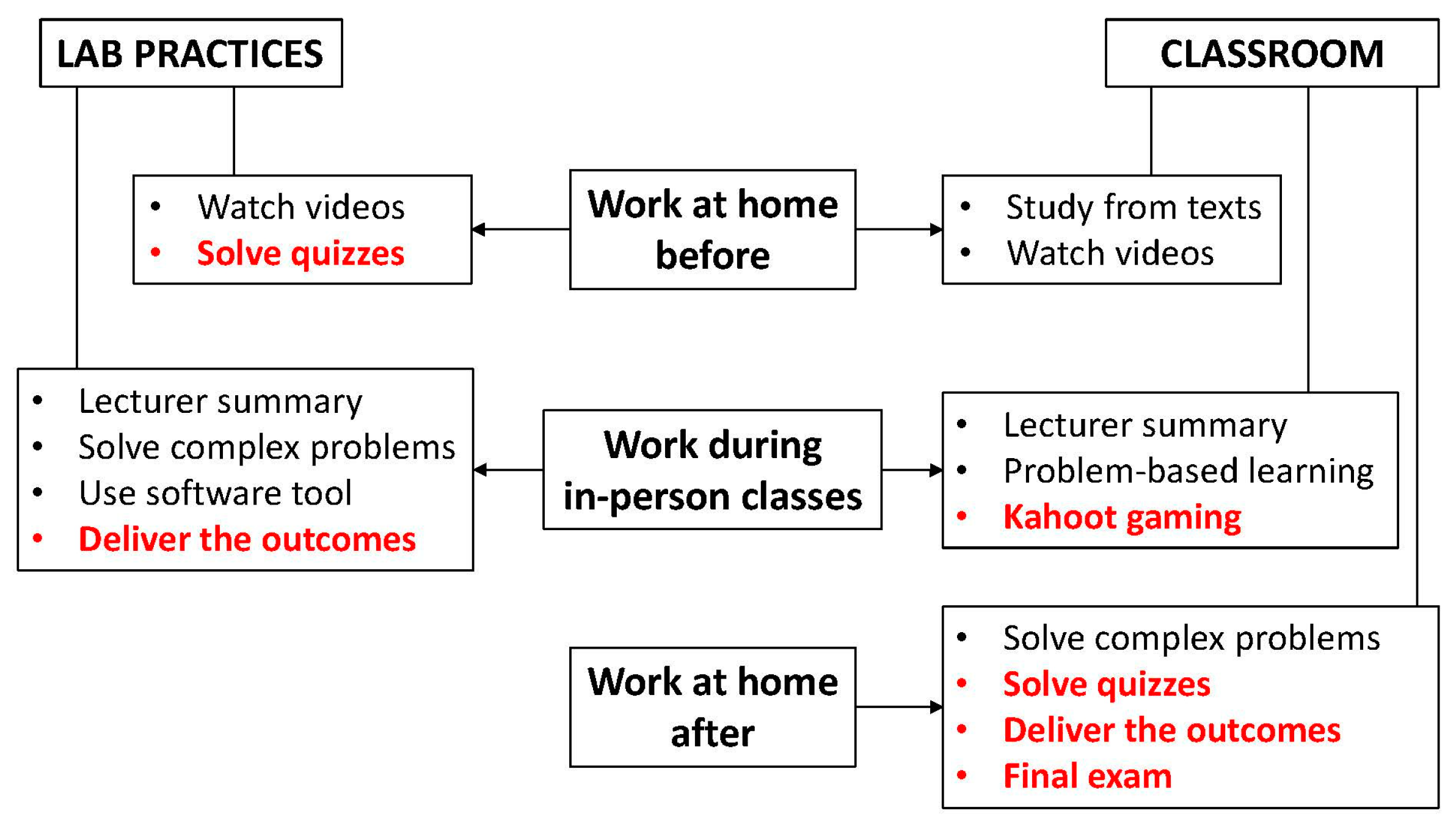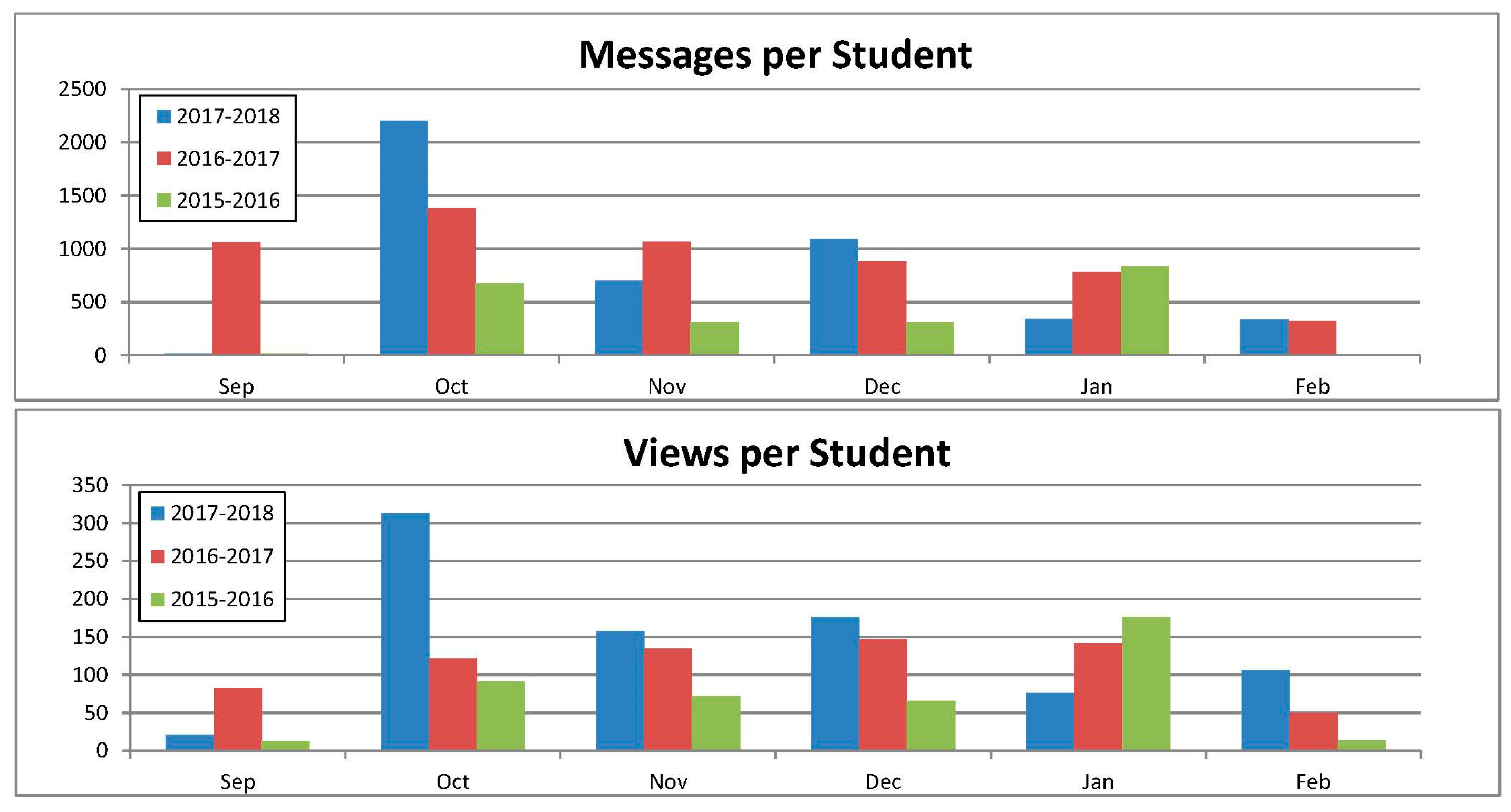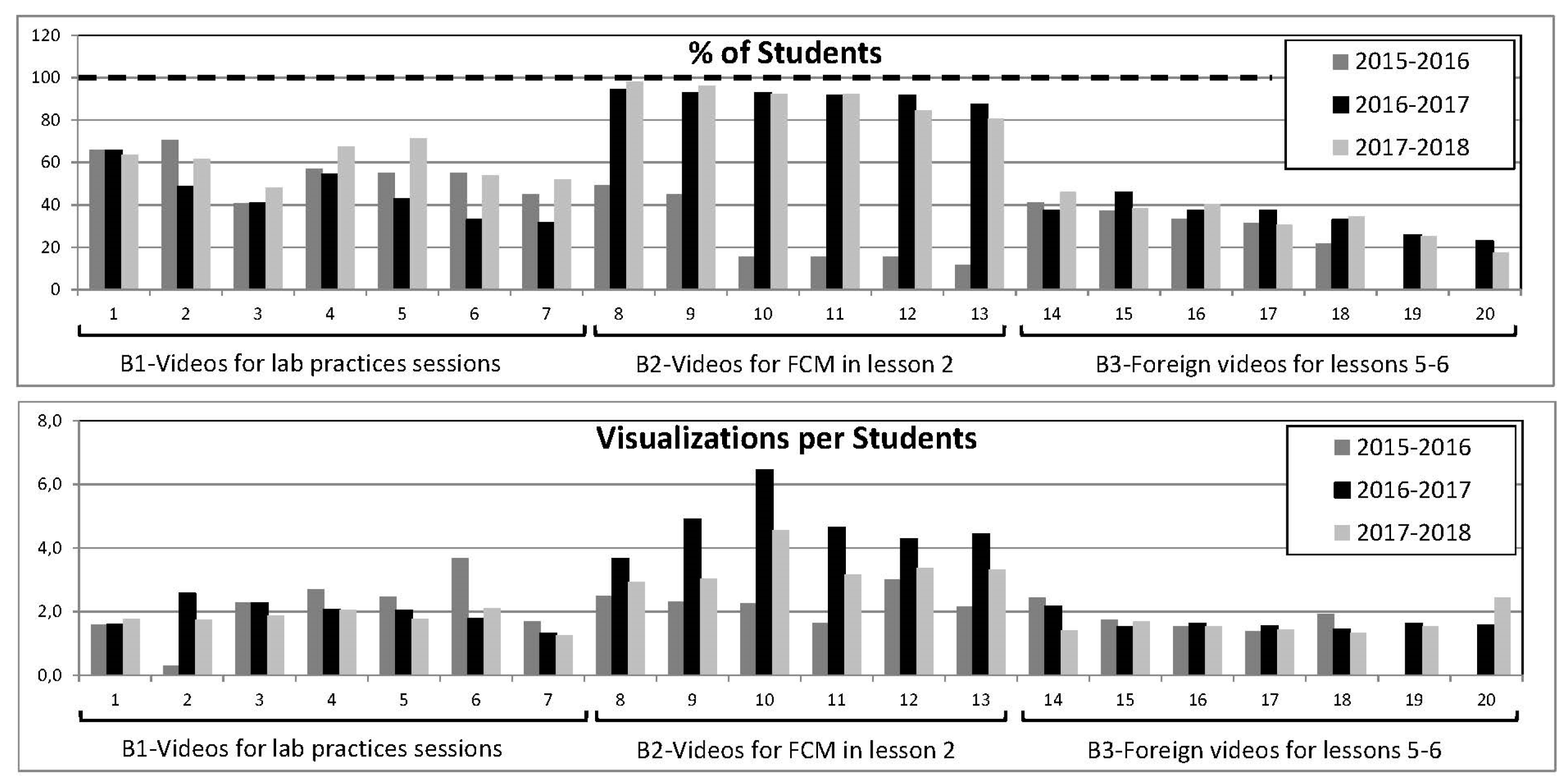Use of Educational Resources and Academic Performance: Analysis and Comparison for the Degree on Engineering of Industrial Technologies †
Abstract
:1. Introduction
2. Materials and Methods
3. Results
5. Conclusions
- It is essential to reduce the possibilities of copying in the assessment tasks.
- Regarding laboratory sessions, it could be useful to make a brief evaluation at the beginning of the session, being able to practice only the students who have actually prepared it.
- As for guided tasks, the use of forms to introduce the results during this course has the advance of automating the correction, but it seems to have encouraged the fraudulent copy, since many more cases have been detected than in previous courses. It will be necessary to take coercive measures or design multiple cases to reduce it.
- Although it is not really the role of the teacher, it seems necessary to remind the student the usefulness of non-compulsory resources such as videos, self-assessment questionnaires or summaries to carry out meaningful and effective learning.
- Implementing an evaluation by rubrics so that the student has clear progress in the course, could be motivating but the teacher has to find an efficient way to manage them, since Moodle tool is not an acceptable option in large groups as for the case study [10].
Acknowledgments
References
- Boyer, A.; Bonnin, G. Higher Education and the Revolution of Learning Analytics. Report of the International Council for Open and Distance Education (ICDE). 2016. Available online: icde.memberclicks.net/assets/RESOURCES/anne_la_report%20cc%20licence.pdf (accessed on 18 April 2018).
- Sclater, N.; Peasgood, A.; Mullan, J. Learning Analytics in Higher Education: A review of UK and international practice. Full Report of Jisc (UK). 2016. Available online: www.jisc.ac.uk/reports/learning-analytics-in-higher-education (accessed on 18 April 2018).
- Wanli, X.; Rui, G.; Eva, P.; Sean, G. Participation-based student final performance prediction model through interpretable Genetic Programming: Integrating learning analytics, educational data mining and theory. Comput. Hum. Behav. 2015, 47, 168–181. [Google Scholar]
- Ferguson, R.; Brasher, A.; Clow, D.; Cooper, A.; Hillaire, G.; Mittelmeier, J.; Rienties, B.; Ullmann, T.; Vuorikari, R. Research Evidence on the Use of Learning Analytics—Implications for Education Policy; Vuorikari, R., Castaño Muñoz, J., Eds.; JRCSP Report; EUR 28294 EN, 2016. Available online: publications.jrc.ec.europa.eu/repository/bitstream/JRC104031/lfna28294enn.pdf (accessed on 18 April 2018).
- Peña, B.; Zabalza, I.; Usón, S.; Llera, E.M.; Martínez, A.; Romeo, L.M. Experiencia piloto de aula invertida para mejorar el proceso de enseñanza-aprendizaje en la asignatura de Termodinámica Técnica. In Actas del Congreso INRED 2017; Universidad Politécnica de Valencia: Valencia, Spain, 2017; Available online: http://ocs.editorial.upv.es/index.php/INRED/INRED2016/paper/view/4430 (accessed on 18 April 2018). [CrossRef]
- Zabalza, I.; Peña, B.; Llera, E.M.; Usón, S.; Martínez, A.; Romeo, L.M. Development of educational videos as reusable learning objects for their integration into an Open Courseware on fundamentals of thermodynamics and thermal engineering. In Proceedings of the 11th Annual International Technology, Education and Development Conference (INTED17), Valencia, Spain, 6–8 March 2017; IATED Academy: Valencia, Spain, 2017; pp. 4453–4461. [Google Scholar] [CrossRef]
- Peña, B. Uso de recursos y rendimiento en las actividades evaluación: Análisis y comparación de resultados en el Grado en Ingeniería de Tecnologías Industriales. In Actas del Congreso INRED 2018; Universidad Politécnica de Valencia: Valencia, Spain, 2018; Available online: http://ocs.editorial.upv.es/index.php/INRED/INRED2018/paper/viewFile/8583/4153 (accessed on 30 August 2018). [CrossRef]
- Moodle.org. Course Overview Report. 2013. Available online: docs.moodle.org/25/en/Course_overview_report (accessed on 19 April 2018).
- Zabalza, I.; Peña, B.; Llera, E.M.; Usón, S. Improving the teaching-learning process using educational videos as reusable learning objects in the field of Thermal Engineering. In Proceedings of the 8th International Conference on Education and New Learning Technologies (EDULEARN16), Barcelona, Spain, 4–6 July 2016; IATED Academy: Barcelona, Spain, 2016; pp. 363–372. [Google Scholar] [CrossRef]
- Peña, B. Defining quantitative and automated rubrics from assessment activities scores. In Proceedings of the 10th Annual International Technology, Education and Development Conference (EDULEARN18), Palma de Mallorca, Spain, 2–4 July 2018; IATED Academy: Valencia, Spain, 2018; pp. 2054–2058. [Google Scholar] [CrossRef]



| Course | S (%) | A/S | T/A (min) | T/Q (min) | Grade | A | S (%) | A/S |
|---|---|---|---|---|---|---|---|---|
| 2015–2016 | 71.4 | 1.7 | 24 | 2.4 | 5.3 | 303 | 29.9 | 2.5 |
| 2016–2017 | 73.3 | 1.7 | 22 | 1.9 | 6.6 | 285 | 35.3 | 1.6 |
| 2017–2018 | 77.4 | 1.8 | 15 | 1.0 | 7.3 | 140 | 25.2 | 1.3 |
| Curso | 2015–2016 | 2016–2017 | 2017–2018 |
|---|---|---|---|
| Number of enrolled students | 42 | 69 | 52 |
| Grade in Moodle questionnaires | 5.3 | 6.6 | 7.3 |
| Grade in guided tasks | 6.8 | 7.4 | 7.7 |
| Grade in final exam (passed students) | 6.5 | 6.2 | 6.4 |
| Students who did the exam (%) | 90.7 | 91.3 | 90.4 |
| Students who passed the exam (%) | 48.7 | 66.7 | 45.8 |
Publisher’s Note: MDPI stays neutral with regard to jurisdictional claims in published maps and institutional affiliations. |
© 2018 by the author. Licensee MDPI, Basel, Switzerland. This article is an open access article distributed under the terms and conditions of the Creative Commons Attribution (CC BY) license (https://creativecommons.org/licenses/by/4.0/).
Share and Cite
Peña, B. Use of Educational Resources and Academic Performance: Analysis and Comparison for the Degree on Engineering of Industrial Technologies. Proceedings 2018, 2, 1330. https://doi.org/10.3390/proceedings2211330
Peña B. Use of Educational Resources and Academic Performance: Analysis and Comparison for the Degree on Engineering of Industrial Technologies. Proceedings. 2018; 2(21):1330. https://doi.org/10.3390/proceedings2211330
Chicago/Turabian StylePeña, Begoña. 2018. "Use of Educational Resources and Academic Performance: Analysis and Comparison for the Degree on Engineering of Industrial Technologies" Proceedings 2, no. 21: 1330. https://doi.org/10.3390/proceedings2211330
APA StylePeña, B. (2018). Use of Educational Resources and Academic Performance: Analysis and Comparison for the Degree on Engineering of Industrial Technologies. Proceedings, 2(21), 1330. https://doi.org/10.3390/proceedings2211330





